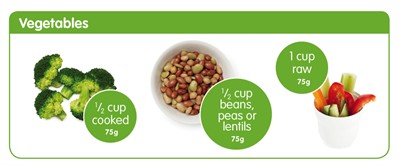Crunch on vegetables
Most WA school kids meet the recommended intake for fruit, but only 1 in 16 eat enough vegetables. Vegies are important for healthy growth and development and reduce the risk of developing diseases such as type 2 diabetes, heart disease and some cancers later in life.
Primary school children need 4½ - 5 serves of vegetables each day. One serve is…

5 ways to eat more vegies
- Send vegetables for Crunch&Sip
If this is new, try starting with sweeter vegetables (like red capsicum) or vegetables your child is more familiar with. Children’s food preferences are shaped by the habits of those around them – show them how much you enjoy eating vegetables!
- Plant a vegie garden with your kids
Research shows that children are more likely to eat vegetables they have grown themselves. Start with quick and easy to grow vegetables like radishes or salad greens. If you don’t have much space, plant pots are a great option.
- Get children involved in meal preparation
Children of all ages can get involved! Younger children can wash vegetables or tear up lettuce, while older children can cut up ingredients, or serve up the final meal. They’ll learn to cook, and are more likely to try food that they’ve helped create.
- Make vegetables an easy snack choice at home
Have ready-to-go snacks in the fridge or pantry like healthy leftovers, cut up vegetables and dip or mini tins of baked beans or corn kernels. If junk foods aren’t available at home, children won’t be able to choose them as a snack!
- Take the pressure off
Make mealtimes a relaxed and sociable occasion and model healthy eating rather than forcing children to eat certain foods. If children feel pressured they may reject foods being encouraged.
If vegetables have become a battleground, try stepping back and encouraging children to explore vegetables without the expectation that they will eat them. For example, create vegie faces or cars with cut-up vegetables and toothpicks, use broccoli florets and potato shapes as paintbrushes to create vegie art, or investigate the colour and texture of different vegetables.